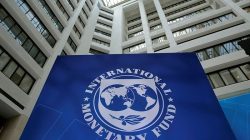1305 ET – Strategists from Rosenberg Research argue that the recent strengthening of the Canadian dollar is “hardly more than an illusion,” driven primarily by overall weakening of the U.S. dollar. This week, USDCAD dropped to an eight-month low beneath $1.37, down from a ten-year high of $1.45 set back in January. According to the analysis provided by the Canadian market research company, despite these fluctuations, the Canadian Dollar still ranks as one of the poorest-performing currencies relative to the U.S. Dollar within the G10 group so far this year.
“There isn’t anything fundamentally supporting this movement in CAD,” they inform their clientele. They highlight several issues plaguing Canada’s economy such as poor productivity rates and stagnation in terms of per capita GDP growth. Additionally, job losses have been recorded across various sectors for the past couple of months, and forecasts predict that the unemployment rate will soon exceed 7%.
[email protected]
; @paulvieira)
The Dollar Is Expected to Maintain Its Preeminence Due to the Absence of Viable Competitors
1400 GMT – Skepticism about the dollar maintaining its status as the global reserve currency seems premature considering the absence of viable substitutes, according to IKB Deutsche Industriebank analysts in a report. “The euro and the Chinese renminbi do not present credible replacements.” Despite Moody’s downgrading of US government debt, America retains the strongest credit score relative to both Europe and China. Although worries persist regarding potential domestic political upheaval affecting faith in the dollar, similar doubts apply to the eurozone and China. The eurozone continues to be viewed as unstable and grapples more intensely with the rise of far-right populists. In parallel, significant political and economic hurdles confront China. Additionally, each region—the US, Eurozone, and China—faces ongoing risks associated with high inflation levels.
[email protected]
)
Central Bank of Hungary’s Inability to Hint at Interest Rate Increases Poses Threat to Forint
1405 GMT – According to Commerzbank currency analyst Tatha Ghose, the unwillingness of Hungary’s central bank to indicate an intention to increase interest rates presents a challenge for the forint. On Tuesday, the central bank maintained its benchmark rate at 6.5%, continuing to express caution about lowering rates. Nevertheless, their lack of commentary regarding potential hikes should the forint weaken amid risky market conditions persists as “a significant worry,” notes Ghose. This situation might encourage forex traders to probe how responsive the central bank would be with a devalued forint. Meanwhile, the euro drops by 0.1% against the forint, trading at 403.279 forints.
[email protected]
)
The Japanese Yen Might Strengthen Despite Increasing Yields Not Likely Altering the BOJ’s Cut-Rate Position
1137 GMT – The Japanese yen might see an uptick soon because increasing long-term Japanese government bond yields likely won’t push the Bank of Japan towards cutting interest rates, MUFG Bank analyst Derek Halpenny notes in his report. “Currently, we believe the BOJ isn’t nearing any change in policy direction, and global elements should support further yen strength in the short run.” Long-term Japanese yield rates dropped significantly on Tuesday following news about potential adjustments to their bond issuance strategy. Nonetheless, a weak result from Thursday’s 40-year Japanese bond sale caused these yields to climb again. Meanwhile, the U.S. dollar has dipped by 0.1%, trading at 144.254 yen, down slightly from Monday’s peak of 144.761, based on data from FactSet.
[email protected]
)
Sterling Continues to Be Underpriced Despite Recent Increases
1056 GMT – Despite its recent gains, the pound continues to trade below its fair value, notably when measured against the euro, asserts Nick Rees, an analyst with Monex Europe. He notes that interest rates and economic growth still offer advantages for the pound. Additionally, the UK appears better shielded from US tariff threats compared to many other nations, such as those within the Eurozone. Nonetheless, data from LSEG indicates that the exchange rate between the euro and the pound has increased by 1.4% since January. “This does not align well with our assessment of fundamental factors,” comments Rees. This year, risk-averse sentiment has weighed down the pound due to concerns over US tariffs, political instability in the UK, and broader negative perceptions about the British economy. At present, the euro stands at 0.8391 pounds, having hit a six-week low point of 0.8371 earlier this week.
[email protected]
)
The Dollar’s Rebound Is Expected to Stay Restricted
0731 GMT – The dollar’s resurgence seems to be capped due to ongoing worries regarding sluggish U.S. economic expansion and persistent issues with the federal budget shortfall, according to an analysis from ING economist Francesco Pesole. He points out that a boost in the Conference Board’s U.S. consumer sentiment report for May has aided the greenback’s climb. Nevertheless, additional favorable statistics will be necessary to restore faith in American economic progress; meanwhile, apprehensions concerning deficits aren’t fading quickly. In the short run, the dollar still faces “negative prospects.” Although higher-than-expected consumer confidence lessens these risks somewhat, we continue to approach the DXY dollar index cautiously without pursuing gains beyond 100 levels. Currently, the DXY inches up by 0.1%, settling at 99.6650.
[email protected]
)
The Euro Would Likely Fail to Surpass the Dollar’s Worldwide Preeminence
0713 GMT – According to Commerzbank’s Thu Lan Nguyen, it seems improbable that the euro could displace the dollar as the leading worldwide currency. In her statement, she points out that the prominence of the US dollar stems from its extensive use in international transactions. She notes that back in 2017, during Emmanuel Macron’s presidential campaign advocating increased union within the Eurozone, the euro nearly rivaled the dollar in this capacity. However, once he won office, investor confidence waned due to growing disenchantment over time.
“A currency inherently tied to the possibility of breaking apart would naturally find it hard to establish itself as an essential transactional medium,” Nguyen explains. This suggests that overtaking the position held by the US dollar remains a significant challenge.
[email protected]
)
The Dollar Increases as Reduced Yields Alleviate Debt Concerns
0641 GMT – The dollar strengthens following a decrease in the yields of long-term Treasury bonds, which alleviated concerns regarding the direction of U.S. national debt, according to an analysis by Deutsche Bank analysts. On Tuesday, a significant drop in ultra-long Japanese government bond yields—sparked by rumors suggesting potential adjustments in their bond issuance strategy—had a ripple effect on Treasuries as well. Additionally, better-than-expected U.S. consumer confidence figures released by the Conference Board further bolstered the dollar. These numbers suggest that a severe economic slowdown might not occur, as noted by the analysts. Furthermore, increasing hopes for upcoming trade agreements have emerged, notably after President Trump postponed proposed European Union tariffs. As a result, the DXY dollar index climbs by 0.2%, reaching 99.712.
[email protected]
)






